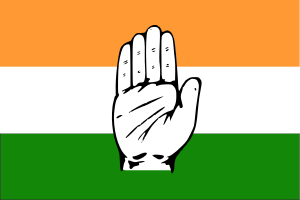Jammu and Kashmir Legislative Assembly election, 1977
| | ||||||||||||||||||||||||||||||||||||||||||||||||||||||||||
| ||||||||||||||||||||||||||||||||||||||||||||||||||||||||||
| ||||||||||||||||||||||||||||||||||||||||||||||||||||||||||
| ||||||||||||||||||||||||||||||||||||||||||||||||||||||||||
Elections for the Indian state of Jammu and Kashmir were held over June 1977,[1] which are generally regarded as the first 'free and fair' elections in the state.[2] Jammu & Kashmir National Conference, newly revived from the former Plebiscite Front, won an overwhelming majority and re-elected Sheikh Abdullah as the Chief Minister.[3]
Background
After reaching the 1974 Indira-Sheikh accord, Sheikh Abdullah was elected as the Chief Minister of Jammu and Kashmir by the ruling Indian National Congress party in the state legislature (which had in fact been the original National Conference founded by Abdullah in 1930s but merged into Congress prior to the 1967 elections). Abdullah remained in power during the National Emergency imposed by Indira Gandhi in 1975. After the Emergency was lifted, the Janata Party came to power in the Centre in the 1977 general election.[4]
Elections were called for the state Legislative Assembly in June 1977. Sheikh Abudllah now revived the National Conference from the erstwhile Plebiscite Front. The National Conference and Congress met head on as equals, the first time such an electoral contest occurred since the State's Accession in 1947. The Prime Minister Morarji Desai (of the Janata Party) took steps to strengthen security in the state and declared that any rigging would be severely punished. This had a salutary effect in the political atmosphere in the state witnessing its first 'free and fair' election.[5]
The revival of the National Conference was greeted with great enthusiasm in the Kashmir Valley. In the words of a Kashmiri, "the entire valley was red with N. C. flags. Every house and every market stood decorated with bunting."[2]
Results
The National Conference won the majority in the Assembly with 47 of the 76 seats.[6] Whereas it won 40 of the 42 seats in Kashmir Valley, it was able to win only 7 seats out of 32 in Jammu.[7]
The Indian National Congress (former National Conference, which had been in power since the State's accesion) was reduced to the third place, winning 11 seats in Jammu and none in the Valley.[7]
The Janata Party (including the former Praja Parishad) won 13 seats, its best performance so far. In addition to 11 seats in Jammu, it won 2 seats in the Valley for the first time.[7]
Also significant is the fact Jamaat-e-Islami won only one seat, down from 5 seats in the previous Assembly.[6]
References
- ↑ 1977 J&K elections
- 1 2 Guha 2008, Section 23.III.
- ↑ Statistical report J&K 1977
- ↑ Guha 2008, Chapter 23.
- ↑ Widmalm 1997, pp. 1006-1007.
- 1 2 Widmalm 1997, p. 1007.
- 1 2 3 Bose 2003, pp. 89-90.
Bibliography
- Bose, Sumantra (2003), Kashmir: Roots of Conflict, Paths to Peace, Harvard University Press, ISBN 0-674-01173-2
- Guha, Ramachandra (2008), India after Gandhi: The History of the World's Largest Democracy, Pan Macmillian, ISBN 0330396110
- Widmalm, Sten (November 1997), "The Rise and Fall of Democracy in Jammu and Kashmir", Asian Survey, 37 (11): 1005–1030, JSTOR 2645738

.svg.png)
